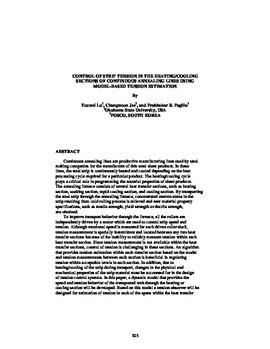| dc.contributor.author | Lu, Youwei | |
| dc.contributor.author | Jee, Changwoon | |
| dc.contributor.author | Pagilla, Prabhakar R. | |
| dc.contributor.other | International Conference on Web Handling (2015) | |
| dc.date.accessioned | 2019-11-12T17:30:09Z | |
| dc.date.available | 2019-11-12T17:30:09Z | |
| dc.date.issued | 2015-06 | |
| dc.identifier | oksd_icwh_2015_lu | |
| dc.identifier.citation | Lu, Y., Jee, C., & Pagilla, P. R. (2015, June). Control of strip tension in the heating/cooling sections of continuous annealing lines using model-based tension estimation. Paper presented at the Thirteenth International Conference on Web Handling (IWEB), Stillwater, OK. | |
| dc.identifier.uri | https://hdl.handle.net/11244/322031 | |
| dc.description.abstract | Continuous annealing lines are productive manufacturing lines used by steel making companies for the manufacture of thin steel sheet products. In these lines, the steel strip is continuously heated and cooled depending on the heat processing cycle required for a particular product. The heating/cooling cycle plays a critical role in programming the material properties of sheet products. The annealing furnace consists of several heat transfer sections, such as heating section, soaking section, rapid cooling section, and cooling section. By transporting the steel strip through the annealing furnace, concentrated uneven stress in the strip resulting from cold rolling process is relieved and new material property specifications, such as tensile strength, yield strength or ductile strength, are obtained. | |
| dc.description.abstract | To improve transport behavior through the furnace, all the rollers are independently driven by a motor which are used to control strip speed and tension. Although rotational speed is measured for each driven roller shaft, tension measurement is spatially intermittent and located between any two heat transfer sections because of the inability to reliably measure tension within each heat transfer section. Since tension measurement is not available within the heat transfer sections, control of tension is challenging in these sections. An algorithm that provides tension estimation within each transfer section based on the model and tension measurements between each section is beneficial in regulating tension within acceptable levels in each section. In addition, due to heating/cooling of the strip during transport, changes in the physical and mechanical properties of the strip material must be accounted for in the design of tension control systems. In this paper, a dynamic model that provides the speed and tension behavior of the transported web through the heating or cooling section will be developed. Based on this model a tension observer will be designed for estimation of tension in each of the spans within the heat transfer section. A control system for each driven roller will be designed to regulate web speed and tension and results of computer simulations of the model and the control system will be presented and discussed. | |
| dc.format | application/pdf | |
| dc.language | en_US | |
| dc.publisher | Oklahoma State University | |
| dc.rights | In the Oklahoma State University Library's institutional repository this paper is made available through the open access principles and the terms of agreement/consent between the author(s) and the publisher. The permission policy on the use, reproduction or distribution of the article falls under fair use for educational, scholarship, and research purposes. Contact Digital Resources and Discovery Services at lib-dls@okstate.edu or 405-744-9161 for further information. | |
| dc.title | Control of strip tension in the heating/cooling sections of continuous annealing lines using model-based tension estimation | |
| osu.filename | oksd_icwh_2015_lu.pdf | |
| dc.description.department | Mechanical and Aerospace Engineering | |
| dc.type.genre | Conference proceedings | |
| dc.type.material | Text | |
